I have a very long line of random numbers, e.g. 234,364...,632. I want to insert this line into a SQL temp table so that I can use it in an IN (SELECT * FROM #MYTABLE) statement of various queries. How can I do that? Apparently there is not an easy way to insert this list into a column in a table. I was thinking to insert it as a row and then pivot the table. Any solution please?
Asked
Active
Viewed 496 times
0
user13654090
- 41
- 2
-
9Please _don't_ do this; store each number in a separate record instead. – Tim Biegeleisen Feb 18 '21 at 12:30
-
There is not such thing as a "list" or "array" in tsql. Do you have a string (scalar value - perhaps a local variable or a paramter) containing numbers separated by commas? – SMor Feb 18 '21 at 12:37
-
You're sitting there staring at a relational data storage system and trying to figure out how to not use it as relational storage. Why? Do what @TimBiegeleisen says. – Grant Fritchey Feb 18 '21 at 13:26
-
OK but what is your proposal actually? The numbers in the line change and I want to easily update the list. I then want to use the updated list in various statements within the same query. What is the best approach? Obviously, I cannot insert each number into a table, this will create a 4,000 lines query as my list has 4,000 numbers. – user13654090 Feb 18 '21 at 14:25
-
Use a Table-Valued Parameter – Charlieface Feb 18 '21 at 14:29
-
Does this answer your question? ['Must Declare the Scalar Variable' Error When Passing a Table-Valued Parameter to a Parameterized SQL Statement](https://stackoverflow.com/questions/66065761/must-declare-the-scalar-variable-error-when-passing-a-table-valued-parameter-t) – Charlieface Feb 18 '21 at 14:30
-
Having already supplied an answer, I'm reluctant to mark this as a duplicate, but many similar questions have been asked: e.g. https://stackoverflow.com/questions/10914576/t-sql-split-string – Steve Lovell Feb 18 '21 at 14:41
-
`I cannot insert each number into a table, this will create a 4,000 lines query` What's the problem with a 4000 line query? That's actualy what table-valued-parameters do under the hood. – Alejandro Feb 18 '21 at 14:41
-
There's no problem with long insert statements like `INSERT INTO #mytable VALUES (234),(364),(...),(632)` to create 4000 rows. – MatBailie Feb 18 '21 at 16:19
-
@Alejandro TVPs most certainly [do not do 4000 queries](https://stackoverflow.com/questions/56744315/populate-a-table-valued-parameter-in-ado-net-with-one-insert-statement-for-multi), they use a special Bulk Insert parameter binding via the TDS protocol, it's just the way Profiler shows it as separate inserts. – Charlieface Feb 19 '21 at 00:58
2 Answers
0
If you're using a sufficiently recent version of SQL Server (2016 or later), STRING_SPLIT could be useful:
CREATE TABLE #MyTempTable (RandomNumber int)
INSERT INTO #MyTempTable
SELECT
ss.Value
FROM
STRING_SPLIT('1234,5678',',') ss
SELECT
tt.RandomNumber
FROM
#MyTempTable tt
Steve Lovell
- 2,564
- 2
- 13
- 16
0
One way to handle this is to perform what I call an "Indexed Split".
For that you would need a tally (AKA numbers) table.
SET NOCOUNT ON;
USE tempdb;
GO
--==== 1. Numbers table setup
-- Create the table
IF OBJECT_ID('dbo.tally') IS NOT NULL DROP TABLE dbo.tally;
CREATE TABLE dbo.tally (N INT NOT NULL);
-- Add Primary Key (I do it here so that I can name it)
ALTER TABLE dbo.tally
ADD CONSTRAINT pk_cl_tally PRIMARY KEY CLUSTERED(N)
WITH FILLFACTOR=100;
-- Add a Unique Index (the optimizer will pick this one)
ALTER TABLE dbo.tally
ADD CONSTRAINT uq_tally UNIQUE NONCLUSTERED(N);
-- Add rows (100K should do)
INSERT dbo.tally
SELECT TOP(100000) ROW_NUMBER() OVER (ORDER BY (SELECT NULL))
FROM sys.all_columns, sys.all_columns a
Next for some sample data to be used for the split.
--==== 2. Sample data
CREATE TABLE dbo.Test (ID INT, Column1 VARCHAR(20));
INSERT INTO dbo.Test (ID,Column1)
VALUES (1,'ORM;PS;SUP'),(2,'ABC;XYZ;999;123');
Now that we have our data, let's use our tally table to "pre-split" the string:
--==== 3. Indexed view to perform the "split"
-- The view
CREATE OR ALTER VIEW dbo.TestSplit WITH SCHEMABINDING AS
SELECT
Id = t.ID,
item =
SUBSTRING
(
t.Column1,
tt.N+SIGN(tt.N-1),
ISNULL(NULLIF((CHARINDEX(';',t.Column1,tt.N+1)),0),LEN(t.Column1)+1)-(tt.N)-SIGN(tt.N-1)
),
ItemIndex = tt.N+1
FROM dbo.Test AS t
CROSS JOIN dbo.tally AS tt
WHERE tt.N <= LEN(t.Column1)
AND (tt.N = 1 OR SUBSTRING(t.column1,tt.N,1) = ';');
GO
-- The index
CREATE UNIQUE CLUSTERED INDEX uq_cl__testSplit ON dbo.TestSplit(Id,Item);
GO
Now you have the strings in the table, unchanged while the indexed view gives you a properly normalized view with your values "pre-split" and ready for retrieval.
--==== 4. Test and review execution plan
SELECT sv.*
FROM dbo.TestSplit AS sv;
Results:
Id item ItemIndex
----------- -------------------- -----------
1 ORM 2
1 PS 5
1 SUP 8
2 123 13
2 999 9
2 ABC 2
2 XYZ 5
Note the execution plan:
Lean and clean.
Alan Burstein
- 7,770
- 1
- 15
- 18
